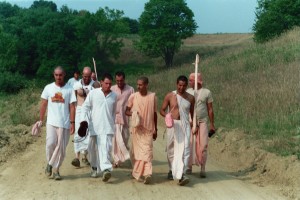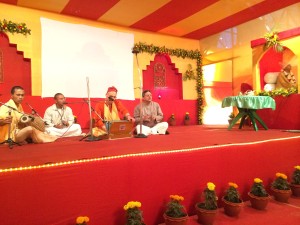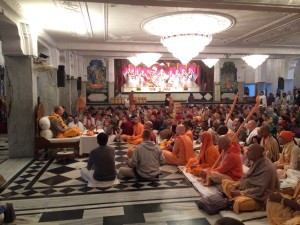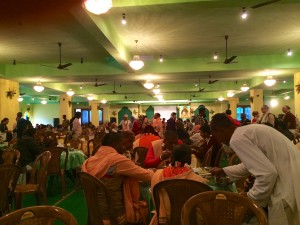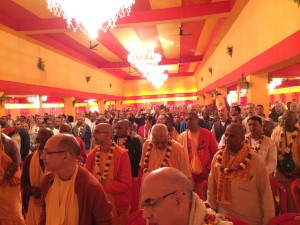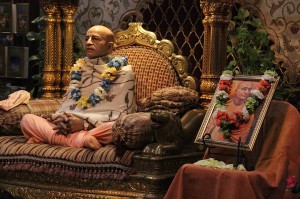Spiritual Leadership Part 1
Wednesday, February 19th, 2014
→ The Walking Monk
Mayapura, India
Tuesday, February 18th, 2014
→ The Walking Monk
Mayapura, India
Monday, February 17th, 2014
→ The Walking Monk
Mayapura, India
Gita 13.18-29 – How the purusha gets bound by prakriti (Hindi)
→ The Spiritual Scientist
ISKCON Leadership Sanga, Day Five – BB Govinda Swami enthuses the devotees! (Album 70 photos)
→ Dandavats.com
 Chanting and hearing transcendental vibrations in the association of devotees: the sublime and authorized method to raise the consciousness to Krishna consciousness! Read more ›
Chanting and hearing transcendental vibrations in the association of devotees: the sublime and authorized method to raise the consciousness to Krishna consciousness! Read more › BECOME A TRUSTED GUIDE
→ Gita Coaching
An experience with the power of vani
→ SivaramaSwami.com
The post An experience with the power of vani appeared first on SivaramaSwami.com.
Prabhupada Letters :: Anthology 2014-02-20 12:00:00 →
"Today, recorded Introduction to Geetopanishad, two sides, three Hours. Mr. Banerji did not come. Cohen and Salak came."
Prabhupada Journal :: 1966
Prabhupada Letters :: Anthology 2014-02-20 11:54:00 →
Prabhupada Letters :: 1968
How do I get to Mayapur?!
→ Mayapur.com
Hope you are getting ready for your visit to Mayapur for the Gaura Purnima 2014 festival. Gauranga Travels, ISKCON Mayapur’s travel department is happy to welcome all the devotees worldwide to Sri Mayapur dhama for Gaura Purnima festival in Sri Mayapur dhama. Gauranga Travels is ISKCON Mayapur temple owned cab services. For your safety and […]
The post How do I get to Mayapur?! appeared first on Mayapur.com.
Devotees in rapt attention during the Srimad Bhagavatam class in Mayapur Dhama (Album 54 photos)
→ Dandavats.com
 ISKCON Leadership Sanga, Day Five - Bhakti Caru Swami class Read more ›
ISKCON Leadership Sanga, Day Five - Bhakti Caru Swami class Read more › ISKCON Leadership Sanga
→ Mayapur.com
Around 800 devotees gathered in Mayapur to attaned the annual ISKCON Leadership Sanga The 2014 ISKCON Leadership Sanga (ILS) was inaugurated on Sunday, February 16, 2014 in Sridham Mayapur. During and after the morning program, crowds of devotees could be seen registering for the event whereupon each attendee was given a reusable jute bag packed […]
The post ISKCON Leadership Sanga appeared first on Mayapur.com.
Prabhupada Letters :: Anthology 2014-02-20 11:27:00 →
Prabhupada Letters :: 1969
Prabhupada Letters :: Anthology 2014-02-20 10:46:00 →
Prabhupada Letters :: 1970
Prabhupada Letters :: Anthology 2014-02-20 10:17:00 →
Prabhupada Letters :: 1972
Prabhupada Letters :: Anthology 2014-02-20 10:12:00 →
Prabhupada Letters :: 1972
Prabhupada Letters :: Anthology 2014-02-20 10:10:00 →
Prabhupada Letters :: 1972
Giriraj Swami’s dream about the recently departed Ram Prasad Dasa (ACBSP)
→ Dandavats.com
 Giriraj Swami: The night Ram Prasad (ACBSP) left this world, he appeared in my dream. Entering his room and seeing him so ill on his bed, I embraced him, and he embraced me back, and we both shed tears of love. Then he suddenly jumped out of bed and said, “I want to go for a ride – with you.” We got into a big vehicle, him in the driver’s seat and me in the passenger’s seat, and he drove us in the early hours of the morning, until the sun was bright in the clear sky. Read more ›
Giriraj Swami: The night Ram Prasad (ACBSP) left this world, he appeared in my dream. Entering his room and seeing him so ill on his bed, I embraced him, and he embraced me back, and we both shed tears of love. Then he suddenly jumped out of bed and said, “I want to go for a ride – with you.” We got into a big vehicle, him in the driver’s seat and me in the passenger’s seat, and he drove us in the early hours of the morning, until the sun was bright in the clear sky. Read more › New Vrindaban’s Transcendental “Throwback Thursday” – 02/20/14.
→ New Vrindaban Brijabasi Spirit
New Vrindaban’s Transcendental “Throwback Thursday” – 02/20/14.
Each week we highlight an earlier era of ISKCON New Vrindaban.
This week’s challenge: There are nine devotees in the photo. Who can correctly identify them all?
Post your guesses on the “who, what, when & where” in the comment section at the New Vrindaban Facebook Page.
Technical stuff: We share the photo Thursday and confirm known details Sunday. Let’s keep it light and have a bit of fun!
Special request: If you have a photo showing New Vrindaban devotees in action, share it with us and we’ll use it in a future posting.
Yukta Vairgya and the Gas Drilling Contract
→ New Vrindaban Brijabasi Spirit
Yukta Vairgya and the Gas Drilling Contract
By Varsana Swami
BACKGROUND
When New Vrindaban was founded in 1968, Srila Prabhupada intended that the devotees would live off the land. My suggestion for the proper spiritual dynamic is that some of the funds obtained from the land should be re-invested back into the land in order to maintain, protect, and revive her. This includes roads, dams, firewood, water, food production, soil conservation, forest management, and watershed management. It also includes making restitution for neglect that has occurred.
The dynamic in New Vrindaban since the mid-1970’s is that we are not putting financial funds and other resources back into the land, at least from a conservation point of view. The justification is that there is not enough money.
An industrial enterprise is exploitive if it takes more from the earth than it gives back. The gas drilling industry is an exploitive industrial enterprise.
By definition, any exploitive enterprise is unsustainable and contributes to the culture of death and toxicity. The consequences of exploitive industrial enterprises are the deterioration of the social and domestic order, quality of relationships, and state of our individual and collective consciousness.
We create our joys and sorrows long before we experience them. The gas contracts are just the most recent and dramatic example of taking from the land for financial purposes.
At this point, our individual and collective dependence on fossil fuel and technology is so entrenched into our daily lives that most of us could not live without them. Still, there is denial about this addiction.
This history of exploiting the land without restitution has made most of us so addicted to and dependent upon fossil fuels, that it could be viewed as hypocritical to now refuse on philosophical and moral grounds to derive some benefit from the drilling.
QUESTION PRESENTED
Srila Prabhupada was against mining and drilling for fossil fuels in or around the dham. The issue is whether ISKCON New Vindaban can justify signing a gas drilling contract by setting aside a pre-determined percentage or amount of the proceeds to maintain, protect, and revive the land?
SPIRITUAL PRINCIPLE: YUKTA VAIRAGYA
I am not for or against signing the gas drilling contract. My opinion would be based on the understanding, intent and plan regarding what to do with the proceeds. Specifically, my opinion would be based on what ISKCON New Vrindaban will do in order to merit Lord Krsna’s qualification for yukta vairagya.
Yukta vairagya means that assets that can be utilized in Krsna’s service should not be rejected or neglected by considering them to be mundane. Yukta vairagya is one of the most frequently misapplied principles of Srila Prabhupada’s teachings. Yukta vairagya is misapplied because we have a conditioned propensity to mistake what is necessary for Krsna’s service with services we are inclined to offer with mixed motives, including our own comfort and convenience.
Proper application of yukta vairagya has three elements: (1) detachment from the asset, (2) realization regarding the tainted nature of the asset, and (3) a strategy to become free from the asset. Each of these three elements will be discussed below:
1. Detachment from the asset
Due to our conditioning, we have the propensity to mistake what is necessary for Krsna’s service with that which is simply for our own comfort and convenience. In order to determine whether the services rendered by use of a tainted asset will be pleasing enough to Krsna to justify its use, a person either must be sufficiently free from personal motives or else must accept guidance from someone who has sufficient detachment.
2. Realization regarding the tainted nature of the asset
When an asset is accepted from a non-devotee or a mixed devotee, the asset is infected with the modes of material nature. Contact with the infected object creates the tendency to use the object for name and fame, which clouds the user’s discrimination between Krsna’s pleasure and our own pleasure.
3. Strategy to become free from the asset
Laxmi is wealth in land, cows, oxen, grains, and other sattvic assets. It is real opulence. It is wealth in the mode of goodness, which has duration and an uplifting influence. Laxmi’s influence is to draw us to the altar of sacrifice with a clear vision of Krsna’s pleasure.
Chanchala means wealth tainted with passion and ignorance. It is fleeting and cheap, it doesn’t stay with you. The influence of chanchala is to draw us towards investment in our own pleasure and into a realm where our offerings to Krsna are tainted with our own personal interest.
If you use chanchala, you must have a strategy to become free from it. Otherwise, you will become more entangled by it. The strategy is to invest chanchala in something that will stay with you – land, grains, and cows.
Proper application of the yukta vairagya principle is demonstrated in CC Antya-lila chapter 6 in Lord Caitanya’s dealings with Raghunath das Goswami. Raghunath das Goswami’s parents sent him a fortune for maintaining himself. Initially, Raghunath das Goswami used this asset to prepare opulent meals for Lord Caitanya, which He accepted.
Raghunath das Goswami was detached enough to realize, however, that the income was infected with the mode of passion due to the donor’s consciousness. This infection leads to the misconception that devotees are dependent on materialists for the resources to perform their service.
Understanding that Lord Caitanya would not be pleased by a dependence on an infected source of income, Raghunath das Goswami weaned himself from that that infected source. Lord Caitanya was pleased with that decision because when an offering is tainted with the donor’s consciousness, the recipient becomes infected by that same consciousness which clouds the perception about what is actually pleasing to Krsna.
Lord Caitanya demonstrated His pleasure with Raghunath das Goswami’s approach by gifting him with His two most treasured possessions, His Govardhan sila and His gunja mala. These gifts represent shelter in the shade of Govardhan Hill, which is the essence and source of Vraja’s bounty; and refuge at the lotus feet of Srimati Radharani, representing pure devotional service; and indicate that he would become the steward of Radha kunda in the region of Govardhan.
YUKTA VAIRAGYA AND THE GAS DRILLING CONTRACT
The gas drilling industry is an exploitive industrial enterprise. It is unsustainable and contributes to the culture of death and toxicity. All proceeds derived from gas drilling are chanchala, infected with the modes of passion and ignorance. Anyone who accepts proceeds from gas drilling will be infected and his or her spiritual perception will be compromised unless and until the proceeds are purified.
Wealth, like everything else in this material world, is in need of purification. The process for purification of wealth is giving a portion away in charity. “Charity given out of duty, without expectation of return, at the proper time and place, and to a worthy person is considered to be in the mode of goodness.” Bhagavad-Gita As It Is 17.20.
Additional purification is offered by converting chanchala into laxmi. Thus, one process for purifying the gas proceeds is to convert a portion of the proceeds into laxmi – land, cows, oxen, grains, and other sattvic assets.
Because Srila Prabhupada was against mining and drilling for fossil fuels in or around the dham, accepting proceeds from a gas drilling contract would be especially entangling. All things can be used in Krsna’s service, but the service must be sufficiently pleasing to Him (as revealed through Srila Prabhupada’s instructions) to warrant the risk.
For our individual and collective protection, ISKCON New Vrindaban must have a strong case for yukta vairagya in the matter of the gas contract. In order to qualify for yukta vairagya under my interpretation of the doctrine, three elements must exist: (1) detachment from the gas drilling proceeds, (2) realization regarding the tainted nature of the gas drilling proceeds, and (3) a strategy to become free from fossil fuels. Each of these three elements will be discussed below:
1. Detachment from the gas drilling proceeds
Someone in a decision-making position must have sufficient detachment from the gas proceedings or accept guidance from someone who does have sufficient detachment. This requires personal confession that we are individually and collectively helpless to overcome our addiction to the toxic effects of a plundering society in a world gone mad.
2. Realization regarding the tainted nature of the gas drilling proceeds
We must have realization regarding the current level of New Vrindaban’s dependence on fossil fuels. With humility, we must demonstrate that we are sincerely endeavoring to empty ourselves of attitudes and actions which support the culture of death and obstruct the emergence of the culture of life and loving relationships.
3. A strategy to become free from fossil fuels
The first step to becoming individually and collectively free from fossil fuels is (a) sufficient investment of money and other resources in order to perform restitution to the land, and (b) to return at least one portion of New Vrindaban’s residents and land back to a healthy interdependence with nature’s resources in line with Srila Prabhupada’s vision and instructions. Point (b) be discussed in the next section.
RETURNING AT LEAST ONE PORTION OF NEW VRINDABAN’S LAND BACK TO A HEALHTY INTERDEPENDENCE WITH NATURE’S RESOURCES IN LINE WITH SRILA PRABHUPADA’S VISION ND INSTRUCTIONS
Srila Prabhupada’s instructions for New Vrindaban clearly indicate his will for us to strive for independence from bondage to modern industry and technology. At this stage, preliminary step towards that freedom might be returning at least one portion of New Vrindaban land to the basics of Srila Prabhupada’s vision of human society living in harmony with the eco-system. This means returning to reliance on animal power and other renewable resources, i.e., wind mills. This can be summed up in four words: Plain living and high thinking.
In my opinion, in order to qualify for yukta vairagya, ISKCON New Vrindaban must commit a specific percentage or amount of the gas drilling proceeds along with at least one specific region of the dham, to a practical plan to return to the roots from which this community was inspired by the vision and instructions of Srila Prabhupada.
This plan must be developed before the contract is signed. This plan must be clear, specific, aligned with Srila Prabhupada’s intent, have a timeline, and be properly funded.
In determining which portions of New Vrindaban land would be best suited for this service, there are eight factors to consider. Each of those factors will be discussed below.
- Agricultural potential
- Fertility of the earth
- Irrigation
- Availability of manure
- Protection from wildlife – deer, birds, ground hogs, rabbits, raccoons
- Drainage
- Topography – size of the field, slope of the land
- Natural condition of the soil
- Srila Prabhupada’s personal investment: how much time Srila Prabhupada stayed at the site, his specific instructions for the site
- Historic significance – significance in New Vrindaban history and/or ISKCON history.
- Historic use – agriculture, industry, education, temple worship, residential
- Social integration vs isolation – There are certain social fields within the dham within which devotees feel connected to the rest of the community. Such fields exist primarily around the temple and Palace. The further away from those fields, the less social energy is available.
- Current encroachment of technology: Any region that is already free from technology has a better chance of staying free. At the same time, any region that is already dependent on technology is going to have challenges in becoming free from it.
- Existing infrastructure for prospective residents
- Housing
- Barns
- Roads
- Sewage
- Water
- Electricity
- Other resources committed to the site.
There are five regions of New Vrindaban that could potentially return to a healthy interdependence with nature’s resources in line with Srila Prabhupada’s vision and instructions. The five regions are Old Vrindavan, Madhuvan, Garden of Seven Gates, Bahulavan, and the bottom land adjacent to the Big Barn. Each of the eight factors will be applied to these five regions:
- Old Vrindavan
a. Agricultural potential
- Fertility of the earth – There is one three-acre field that was rejuvenated in the late 1980’s. The soil was adequately built up with top soil and manure. The soil could resume production with minimal preparation
- Irrigation – A drip irrigation system was installed in the late 1980’s. The irrigation pipe lines are still intact and connected to the Rainey well. The logging company did some damage to the drip irrigation system but I am uncertain how much.
- Availability of manure – Long haul from either barn
- Protection from wildlife – A deer fence was installed in the late 1980’s. The deer fence has suffered damage both from the logging company and the time factor Either the fence must be re-built or a dog must take up residence along with the people.
- Drainage – The entire area, including the agricultural field, drains well.
- Topography – good
- Natural condition of the soil – good
b. Srila Prabhupada’s personal investment
- Srila Prabhupada spent more time in Old Vrindaban than in all the other sites in the community combined.
- The residence in which he stayed is still there.
- He planted the seed for entire New Vrindaban concept there.
- He stated that even if no additional land could be acquired, Old Vrindavan would be adequate for his vision of agriculture and seven temples.
c. Historic significance
- Srila Prabhupada planted the seed for his entire farm movement in Old Vrindavan.
- This is the original ISKCON farm – the original temple, as well as residence for SP and the devotees.
- Original residence of Radha Vrindavannath.
d. Historic use – agriculture and temple worship
e. Social integration vs isolation: Old Vrindavan is isolated from the existing social networks. The connection could be re-established in one of two ways. First, devotees could take up residence there, which would be preferable. Second, devotees could work there and have connections with the existing social networks.
f. Current encroachment of technology: There is no current encroachment. This is, however, a site for a future gas well. The time spent fracking would not pose considerable detriment. I am unclear, however, regarding the amount of surface activity after the fracking, so it might be a factor.
g. Existing infrastructure for prospective residents
- Housing – The original farmhouse and temple is still in good condition.
- Barns – The barn is in excellent condition
- Roads – The majority of the work on the road is already done; it requires some maintenance and some gravel. The gas company would finish the road.
- Sewage – none
- Water – There is a pipe line to the Rainey well. There are local springs and ponds. There is one well dug by hand that could be cleaned and revitalized.
- Electricity – The poles are in but the electric is down.
h. Other resources committed to the site – none
2. Madhuvan
a. Agricultural potential
- Fertility of the earth – poor
- Irrigation – none
- Availability of manure – reasonable haul from either barn
- Drainage – good
- Topography – fair
- Natural condition of the soil – poor
b. Srila Prabhupada’s personal investment: Srila Prabhupada lived there for some days but his actual residence has been removed from the site.
c. Historic significance: The first Prabhupada houses were there and Prabhupada expressed his pleasure at them.
d. Historic use – agriculture and temple worship
e. Social integration vs isolation: It is on the outskirts of the social field, but connected.
f. Current encroachment of technology: none
g. Existing infrastructure for prospective residents
- Housing – none
- Barns – none
- Roads – I renovated the old road last year.
- Sewage – none
- Water – one near-by spring and city water
- Electricity – nearby on the road
h. Other resources committed to the site – There is an intention to create an eco-village at the site. Fruit and nut trees have already been planted.
3. Garden of Seven Gates
a. Agricultural potential
- Fertility of the earth – good
- Irrigation – currently available
- Availability of manure – reasonable haul from either barn
- Drainage – fair
- Topography – good
- Natural condition of the soil – acceptable
b. Srila Prabhupada’s personal investment: none
c. Historic significance: none
d. Historic use – agriculture
e. Social integration vs isolation – integrated
f. Current encroachment of technology: complete encroachment
g. Existing infrastructure for prospective residents
- Housing – one earth-sheltered cabin under construction
- Barns – none
- Roads – good
- Sewage – in place
- Water – Rainey well and city water in place
- Electricity – in place
h. Other resources committed to the site – I have heard that a new building will replace the current crumbling shed.
4. Bahulavan
a. Agricultural potential
- Fertility of the earth – poor
- Irrigation – none
- Availability of manure – moderate haul from either barn
- Drainage – acceptable
- Topography – acceptable
- Natural condition of the soil – poor
b. Srila Prabhupada’s personal investment: This is the site of Srila Prabhupada’s Bhagavat Dharma discurses, and the 1972 Janmastami and Vyasa Puja celebrations when devotees came from all over to see Srila Prabhupada.
c. Historic significance
- Many devotees took initiation there.
- Original temple of Radha Vrindaban Chandra
- One of the three original villages in New Vrindaban
- Industrial hub for the development of New Vrindaban
d. Historic use – integration of agriculture, industrial, worship and residential
e. Social integration vs isolation – isolated
f. Current encroachment of technology: high
g. Existing infrastructure for prospective residents
- Housing – none
- Barns – one rehabitable barn
- Roads – good
- Sewage – none
- Water – city water in place; one near-by spring; and one well dug by hand that could be cleaned and revitalized
- Electricity – in place
h. Other resources committed to the site – residence of heavy equipment; warehouse, mechanic/fabricating shop in operation; utility building
5. Bottom land adjacent to the Big Barn
a. Agricultural potential
- Fertility of the earth – good
- Irrigation – not in place, but absolutely required
- Availability of manure – ideal location
- Drainage – considerable sub-surface drainage is already installed
- Topography – excellent
- Natural condition of the soil – excellent
b. Srila Prabhupada’s personal investment: none
c. Historic significance: none
d. Historic use – major residence for the cows and for growing their feed
e. Social integration vs isolation – fairly integrated
f. Current encroachment of technology: high
g. Existing infrastructure for prospective residents
- Housing – no unoccupied housing
- Barns – excellent
- Roads – good
- Sewage – minimal
- Water – machine-drilled wells
- Electricity – available
h. Other resources committed to the site – I am unaware of other resources
CONCLUSION
The gas drilling industry is an exploitive industrial enterprise. Anyone who accepts proceeds from gas drilling will be infected with the modes of passion and ignorance unless he or she qualifies for yukta vairagya.
In order to qualify for yukta vairagya, ISKCON New Vrindaban must commit a specific percentage of the gas drilling proceeds along with at least one specific region of the dham, to a practical plan for living independently from fossil fuel. This plan must be developed before the contract is signed. This plan must be clear, specific, aligned with Srila Prabhupada’s intent, have a timeline, and be properly funded.
Regarding which regions of the dham could perform this service – My first choice is the Garden of Seven Gates because it lends itself highly to integration of the spiritual and agricultural. My second choice is Old Vrindavan because of its historical and spiritual significance, and because of its simplicity. My third choice is Madhuvan because resources are already committed to that location.
Give Us The Tools And We Will Finish The Job!
Bhakti Charu Swami
Prabhupada Letters :: Anthology 2014-02-20 07:55:00 →
Prabhupada Letters :: 1975
When you realize you are going to die…
→ The Enquirer
Free Speech
→ ISKCON News
15/02/2014 H.G.Pancagauda Prabhu SB – 05.03.07
→ Gouranga TV - The Hare Krishna video collection
15/02/2014 H.G.Pancagauda Prabhu SB – 05.03.07
Loads Of Nectar – Iskcon Panihati February 2014
Bhakti Charu Swami
HG Maha Hari Prabhu – Srila Bhaktisiddhanta Saraswati Thakura Appearance Day
→ Kalachandji's Audio Archive
SB 01.05.36 – Chanting integrates the inner devotion and the outer service dimensions of devotional service
→ The Spiritual Scientist
Gita 18.73 – Persistence on our part attracts Krishna’s mercy, unleashing the magic of the holy name
→ The Spiritual Scientist
Gita 18.78 – Spiritual success is sure for the determined chanter
→ The Spiritual Scientist
ISKCON Leadership Sanga
→ Ramai Swami
The 2014 ISKCON Leadership Sanga was attended by around 1000 devotees from all the world.
New Vrindaban Daily darsan @ February 19, 2014.
→ New Vrindaban Brijabasi Spirit
If you leave Vrndavana, if you leave this forest of kalpa-vrksa trees and go to another forest, if you stop talking about the nectar of Vrndavana and take pleasure in other talks, then, knowingly throwing away the sweetest nectar, you desire to eat dog-stool.
[Source : Nectarean Glories of Sri Vrindavana-dhama by Srila Prabodhananda Sarasvati Thakura, 1-67 Translation.]
George Harrison on Chanting the Hare Krishna Mantra
→ ISKCON News
Vedic Planetarium or …?
→ KKSBlog
(Kadamba Kanana Swami, 13 April 2013, Amsterdam, Netherlands, Srimad Bhagavatam Lecture)
Question: Maharaj, can you say a few words on Prabhupada’s mission for the Vedic Planetarium?
 Well, Srila Prabhupada wanted to construct in Mayapur the temple that Srila Bhaktivinoda Thakur had predicted – a huge, large temple. In that temple, he wanted to make a model of the Vedic Planetarium according to Srimad Bhagavatam and he called it a Temple of the Vedic Planetarium.
Well, Srila Prabhupada wanted to construct in Mayapur the temple that Srila Bhaktivinoda Thakur had predicted – a huge, large temple. In that temple, he wanted to make a model of the Vedic Planetarium according to Srimad Bhagavatam and he called it a Temple of the Vedic Planetarium.
So what do we understand by that? Did Prabhupada particularly think that cosmology is very important for us? No, that is not the point. The point is that through this model of the universe which is so important to people, so intriguing to the world of science, something to explore – through that Vedic model, Prabhupada wanted to actually give Bhagavatam. Therefore, it is actually not the Temple of the Vedic Planetarium, it is the Temple of the Bhagavatam.
It is the Bhagavatam that Prabhupada wanted to give to the people! What do we care about the moon? Whether the moon is made out of rocks like in Arizona or whether the moon is made out of green cheese, who cares? I don’t care! Couldn’t care less whether they went to the moon or not. Wish them well but why do we care about the moon! It is said:
ā-brahma-bhuvanāl lokāḥ punar āvartino ‘rjuna mām upetya tu kaunteya punar janma na vidyate (Bhagavad-gita 8.16)
It means that all the planets within the universe are places of misery where repeated birth and death takes place. Thank you! Can we write-off the universe please, can we move to the next topic? Not interested in your universe, you can have it, the whole thing, please take it. I want the spiritual world! That was Prabhupada, that was Prabhupada… So, if you thought he was so interested in a planetarium – no!
His goal was that people who have interest in planetariums and the universe, would come to study it, look at it and be impressed; and with this trick, they would be pulled into the Bhagavatam. Then once they would read the facts about the universe from the Bhagavatam, then the rest of the Bhagavatam would follow and it would end with Krsna in the tenth canto, tasting his sweetness!
Don’t Chant Unconsciously
→ Japa Group
Hare Krishna chanting in rapping style (5 min video)
→ Dandavats.com
 Musical video with Krishna conscious words and modern style of presenting them Read more ›
Musical video with Krishna conscious words and modern style of presenting them Read more › ISKCON Leadership Sanga Day four – Seminars (Album 35 photos)
→ Dandavats.com
 Mayapur Dham Read more ›
Mayapur Dham Read more › God is simultaneously identical with His creation and yet exists in His completeness
→ The Spiritual Scientist
We often say that God created this material world, and this means that God existed before the world. Since the Lord was existing before this material manifestation, He is not subject to this creation. If He were subject to the laws of the material world, how could He have created it? That the Lord is simultaneously identical with His creation and yet exists in His completeness apart from it is stated in Bhagavad-gita.
- Srila Prabhupada, Elevation to Krishna Consciousness : 1 - Choosing Human and Animal lives
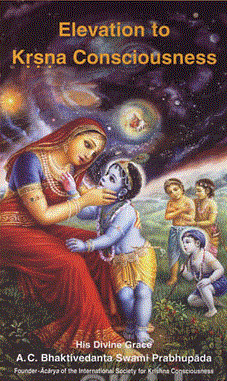
Prabhupada Letters :: Anthology 2014-02-19 16:05:00 →
"Mr. Banerji invited to come here tomorrow evening. In the evening Mr. Paul and Mrs. Leblanc came. Attended meeting from 6/8.30 pm.
Expenditure -- Butter .40"
Prabhupada Journal :: 1966
